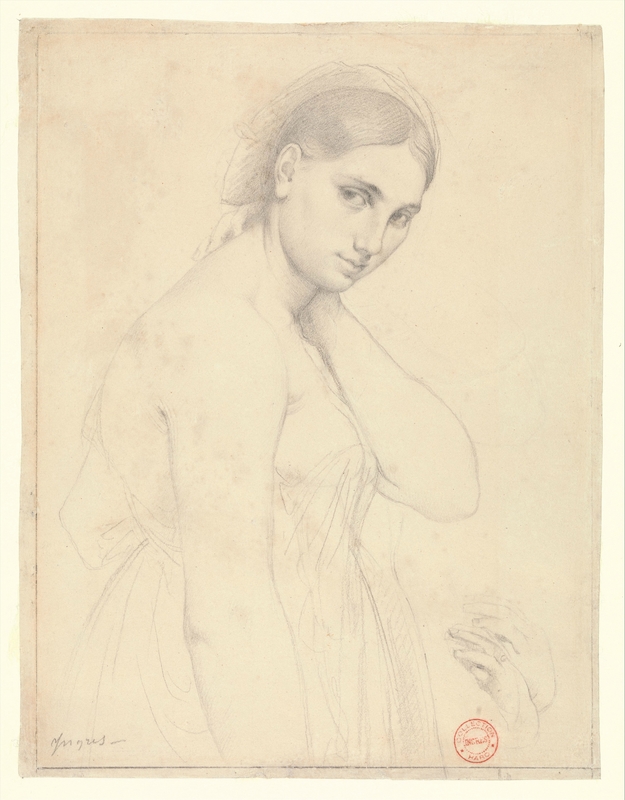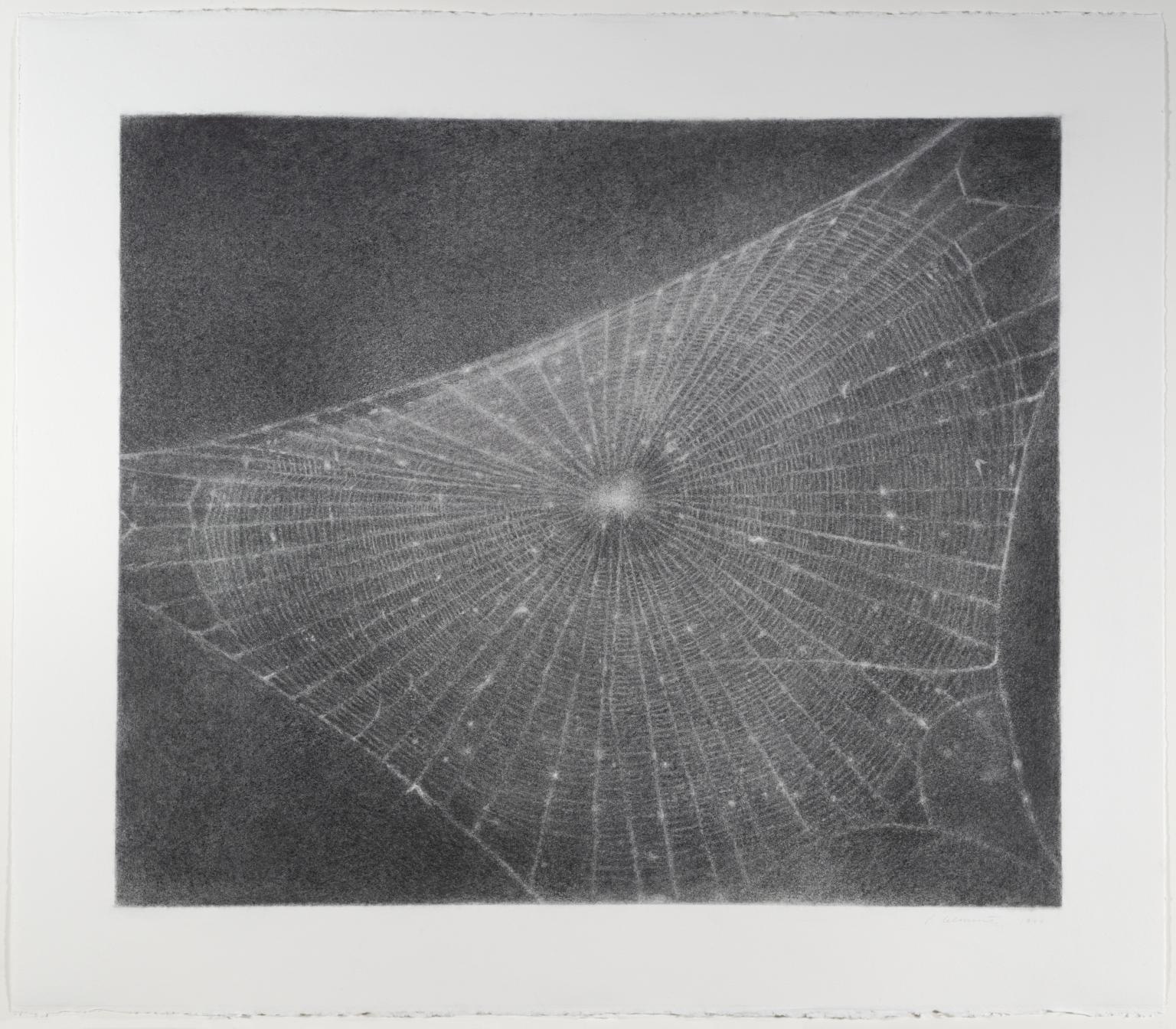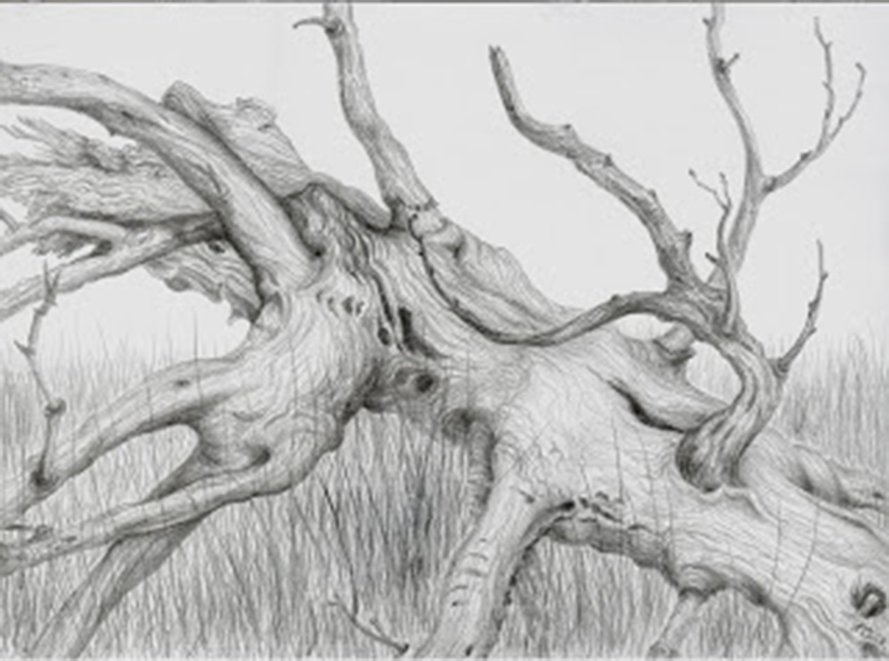A silverpoint drawing of a pine tree in the South Carolina mountains or many others drawings done in coastal Georgia brought back so many memories and sensations as I reorganised my framed art after Hurricane Irma's passage. Their images were an astonishingly powerful trigger that collapsed time.
Read Moregraphite drawing
Nature - Our Outer Skin /
Our outer skin - nature - rewards a closer look on many occasions.
Read MoreThe Eye of the Art Collector /
Thanks - once again! - to ArtDaily.org's listings, I happened on an up-coming Sotheby's sale of old Master Drawings from a private collection. I spent a fascinated hour on their site, going through the E-Catalogue of the drawings, some eighty of them, the ideal occupation for a dark, rainy day.
It is always extremely interesting to view a collection of art formed by one person, particularly a person who has a trained eye and knowledge of the media involved. I quote from the news release about this collector (who apparently spent about 25 years assembling this collection). "In his very personal forward to the sale catalogue, the collector who assembled this remarkable group of drawings wrote that he embarked on collecting “with the bold aim of looking over the artist’s shoulder”. There can be no question that he succeeded in this aim. The light that these extremely varied studies shed on the artistic creative process is both intense and wide ranging: we see every moment in the artist’s thought process revealed and illuminated."
There is a remarkable energy and life evident in the drawings this collector assembled. The artists are clearly in the throes of excitement and creativity. Famous names or not, it does not matter. The hallmarks of these drawings are immediacy, directness, sureness of touch and stroke. The collector does indeed describe well what he sought - and found - when he selected these works. Different media, different subject matter, some clearly well thought-out and planned, others on the spur of the moment, catching images almost on the fly... Some as aide-mémoires, others as exploration. In short, the collection came across to me as a most interesting selection of artists' emotions, desires, endeavours, aims... running a gamut of approaches and techniques. Little interesting items too, such as remarks about an exquisite study of a seated woman by Jean-Antoine Watteau. "It was executed in a combination of media that Watteau used only occasionally, but to striking effect: the majority of the figure is built up with a network of silvery strokes of graphite (a very rare medium in Old Master Drawings), (my emphasis) while the accents in the face and hands are in a more typical red chalk, an extremely effective juxtaposition that creates a lively yet utterly elegant figure."
When you go back and try to find out about the use of graphite before the early 18th century, it is indeed hard, as a neophyte, to find allusions to many graphite drawings. Pure graphite, first mined in Borrowdale, England, in the 1500s, seems initially to have been used for under drawing in the 16th century. It was more forgiving than metalpoint, especially silverpoint, the draughtsman's favoured medium during Renaissance times in spite of silverpoint's linear qualities and permanence of mark. Graphite does not seem to have been used much for drawing until well into the 17th century. Artists tended to favour chalks, red and black, as well as charcoal for studies and finished drawings alike. (Interestingly, the Venetian artists continued to favour black chalk, whilst the perhaps more flamboyant Florentine and Roman artists preferred the harder red chalk with which they could show off their skills!) Graphite became widespread only in the 18th century, with the increasing difficulty of obtaining good-quality natural chalks and the simultaneous production of a fine range of graphite pencils after the invention of a graphite pencil in Nuremberg in 1662.
Graphite drawings then become far more widespread: John Constable, Jongkind and later John Singer Sargent, for example, all used graphite in their work, particularly when working plein air.
Self-Portrait, 1806, John Constable, (Image courtesy of the Tate, London)
Jean Auguste Dominique Ingres (French, 1780-1867). Study for "Raphael and the Fornarina" (detail), ca. 1814. Graphite on white wove paper, 10 x 7 3/4 in. (25.4 x 19.7 cm). The Metropolitan Museum of Art, New York, Robert Lehman Collection, 1975
By the turn of the 19th century, Cezanne and so many others commonly used pencils, as have we all done since in the art world - often to great effect.
Paul Cézanne (1839–1906), Hortense Fiquet (Madame Cézanne) Sewing, ,c. 1880, Graphite
Samuel Courtauld Trust: Princes Gate Bequest, 1978
But back to the Sotheby E-Catalogue of the drawings that occasioned my little foray into the rarity of Old Master graphite drawings... (and by the way, the definition of Old Masters in Western art is work executed before 1800...), it is well worth going through this collection of images of drawings. It allows one to remember how interesting it can be when one sees an art collection formed by one person with the courage of his or her own convictions and erudition.
The Elegance of Imperfection /
Back in May when I was in Spain, I read with interest a long article in El Pais by Antonio Muñoz Molina on the artist Vija Celmins' exhibition then showing at New York's McKee Gallery. The descriptions told of how Celmins works, in her studio, in quiet solitude, communing with objects that she has brought into the studio from walks on the beach or Western deserts, from sidewalk or garage sales in New York or where ever. Her close inspection of the objects then is translated into minutely detailed, intimate paintings and drawings of surfaces, interiors, textures, patterns. Their abstraction and depth, both in tactile effect and message, seem to reach far beyond the mere frames. But always, these images apparently allow for imperfection, as it is first in nature and real life, but more so as she creates her art. The overall effect is powerful and compelling.
Vija Celmins , Web # 1, Charcoal on paper, Image courtesy of Tate / National Galleries of Scotland
Sky, 1975, Vija Celmins, Lithograph on paper, (Image courtesy of the Tate, London)
Her work is very well considered, with awards and exhibitions in major institutions in this country. What interested me was the way she apparently deals with blacks - in paint but especially with graphite. When drawing with graphite, with all its permutations of hardness in the grades of Hs and soft Bs, a lot of skill is need to go on getting a more and more intense black. Unless you are careful, as with pastels, the paper surface gets to such a point of "saturation" that no more graphite will adhere.
What is always fun, when looking at other people's art or reading about it, is to have a sudden idea about something interesting and new to try in one's own art. Thinking about Celmins' work brought back to mind a wonderful goldpoint/platinumpoint drawing I saw in the Telfair Museum of Art metalpoint exhibition, The Luster of Silver, in which I was involved in 2006. Dennis Martin, now sadly deceased, had done the most sensitive and beautiful portrait of his wife. He then surrounded this delicate, almost ethereal three-quarters-size portrait with deep, dark, lustrous graphite. The contrast with the goldpoint drawing was dramatic and most effective.
All these thoughts about artists' skills with graphite are tempting me. Now if the temperatures outside would just diminish a little, I could go off and start doing some drawing plein air!
Silverpoint and graphite drawings from Sapelo /
It is interesting how a beautiful place like Sapelo Island inspires one to do so many different types of art. Now that I have been able to look again at the work I produced last weekend on the Island as Artist-in-Residence, I realise that I managed to produce some very different pieces, ranging all over the place in subject matter and in approach.
Long after the Storm, silverpoint, Jeannine Cook artist
It reminds me how one responds to places and situations in such varied ways. There seems, certainly in my case, to be some unspoken dialogue that goes on subliminally between what one's eyes are seeing and what one instinctively senses could become a drawing or a painting. It is almost beyond cogent thought. You just "know" that that will be a subject worth trying to tackle. It usually ends up humbling one, resulting in a somewhat different result that one visualised... in essence, the subject dictates the whole process. Scouting for possible subject matter is always initially instinctive. Only after one has decided that there is something there to be explored does one try to analyse what exact medium to use and how to go about actually physically doing the artwork. Often this whole process is rapid, because when working plein air, you know that the whole thing is fleeting. Light will change, the tide will alter, the birds will fly off, people might come along to fill the empty scene or whatever.
In any case, I found so many things of fascination to try and draw or paint. These three drawings I am posting are just examples. The Cedar Tree posted above, in silverpoint, was the crown of a huge old tree that had been blown down many years ago and was lying, burnished and reduced to its core, in deep marsh grasses.
Sapelo Dunes was an early morning silverpoint study of the different parts of the dunes facing the restless waves that aided the wind to shape these dunes. Holding the sand against these forces, the sea oats cling tenaciously, their roots amazingly long and lying exposed at the eroded face of the dunes.
Sapelo Dunes, silverpoint, Jeannine Cook artist
The third drawing is a graphite drawing done as the sun was setting on the wide sweep of low-tide beach, the light glinting on the marvellous ridges left in the sand by the water's motion. I was racing the light and only had a very short time before darkness fell. No time for thought, just a fascination to try and make something of nature's marvellous complexity in Low Tide Tracery.
Low Tide Tracery, graphite, Jeannine Cook artist
Gifts of the Moment II /
I wrote yesterday of my magical day drawing, with the added incentive of Sketchcrawl, truly a worldwide day of drawing. Each of us, in our own environment of choice, records and celebrates different drawing media. I was mainly using graphite. These were some of the small drawings I did.
Aground, graphite on tinted ground, Jeannine Cook artist
Cedar Point Pines, graphite on tinted ground, Jeannine Cook artist
Summer Marsh, graphite, Jeannine Cook artist
The Old Dockhouse, graphite, Jeannine Cook artist
The small drawings were all done along a wonderful saltwatercreek near my home. The marshes are wide flung to islands, and the high ground is fringed with majestic old trees that have seen much history.
Gifts of the Moment /
Today was one of those gifts that nature bestows on one a few times each summer along the coast, when the humidity drops, the skies are clear and a gentle breeze makes the world joyously sparkling. It was the perfect day to be out drawing along the marshes, a welcome respite from other activities and concerns. The additional incentive was that it was a day designated for drawing by being part of the international Sketchcrawl group.
It was a day to experiment too, with a slightly different format of graphite drawing, with prepared grounds in different subtle colours. I had seen artist George Sorrels' wonderful Arches drawing book in which he had prepared varying sizes of small squares and rectangles in subtle colour, page by pages. Then, according to the subject matter he found, he would select a prepared area and do a graphite drawing of exquisite beauty and sensitivity. So I prepared paper in a number of colours, and sallied forth.
It was enormous fun to be drawing and experimenting, but more than the fun, there were so many gifts of the moment. The salt water marshes, emerald scintillating to golden, were generous with their ever-changing light. The tide flowed full and then softly ebbed, transforming the whole landscape, with the water surface rippled in a million patterns of light from the on-shore breeze. Osprey keened and sailed above. Herons stalked and drowsed, wood storks dangled their long legs just above the spartina grass as they flapped along to the next hunting ground and gulls dipped into the water and swirled back around to dip again. Marsh wrens chattered endlessly from their hidden perches. Schools of fish made their distinctive whoosh of water parting as they leapt in unison to escape a hidden peril. Time lost any meaning.
I don't know if these gifts of beauty, music and peace show up in the art I did in any way, but as artist Phyllis Purvis-Smith remarked in a March 2009 article in American Artist, "experiencing nature for the artist is also important". I know that after the time spent drawing, I felt utterly restored by the generosity of the day.











